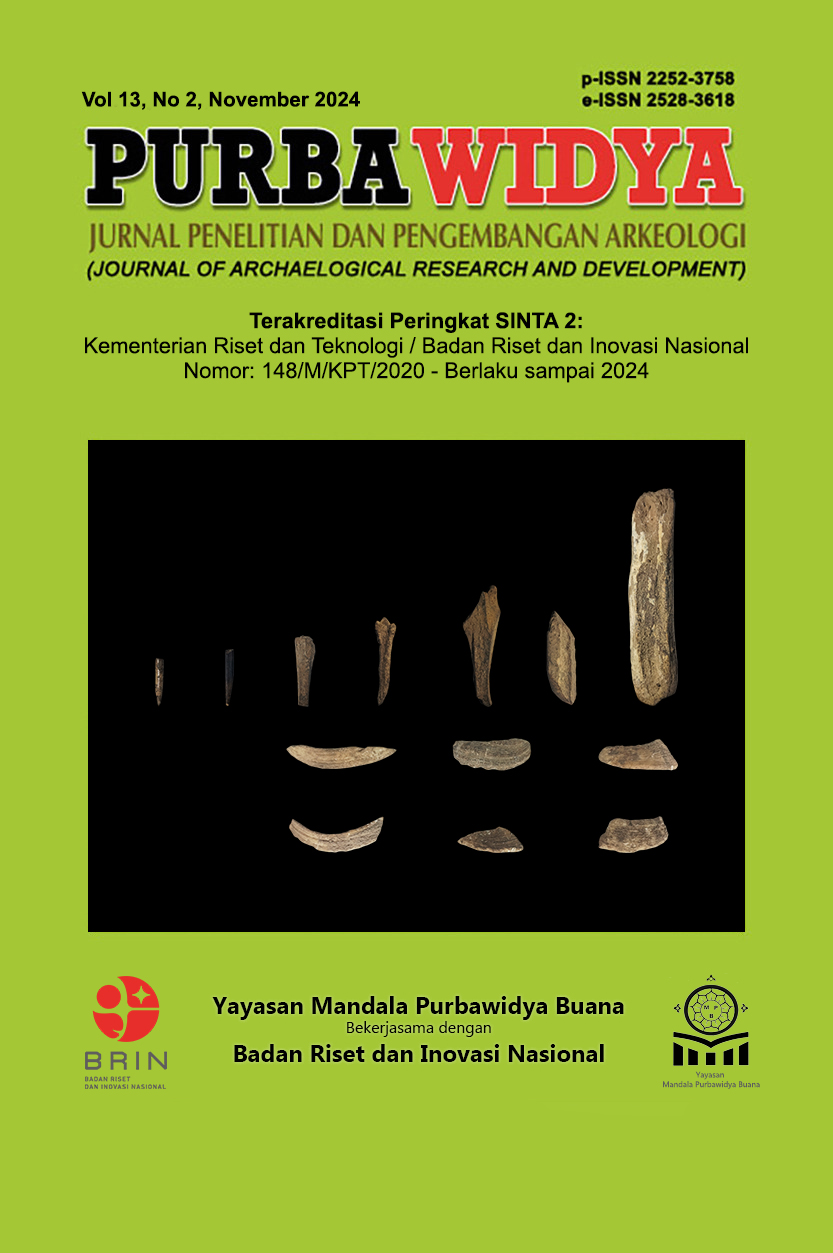Toponimi Kuno Di Daerah Aliran Sungai Nagara, Kalimantan Selatan
Main Article Content
Abstract
The Nagara river basin is an area for developing cultural history in South Kalimantan. The Hikayat Banjar and Tutur Candi tell a lot about historical events and places in this area. Archaeological evidence in this area also confirms the existence of cultural activities in the past. Through archaeo-toponymic studies, this article aims to understand the cultural history of this region. The problem in this article will discuss the meaning of place names and their relationship to the existence of archaeological sites. This research was carried out using a literature study. The data sources used in this study consist of the Hikayat Banjar, Tutur Candi, Archaeological Research Reports, and landform maps. The analysis used is the first archaeo-toponomic model. This analysis requires clarity of place names, locations, and their role in history. The analysis resulted in the interpretation that three place names played an important role in the course of cultural history in this area, namely Ujung Tanah, Candi, and Nagara. The third toponymy is spread along the Nagara River Basin and each of its meanings is related to events in the two literary works. Archaeological sites discovered in these places indicate cultural activities in the past.
Article Details

This work is licensed under a Creative Commons Attribution-NonCommercial-ShareAlike 4.0 International License.
Authors who publish with this journal agree to the following terms:
- Authors retain copyright and grant the journal right of first publication with the work simultaneously licensed under Creative Commons Attribution-NonCommercial-ShareAlike 4.0 International License that allows others to share the work with an acknowledgement of the work's authorship and initial publication in this journal.
- Authors are able to enter into separate, additional contractual arrangements for the non-exclusive distribution of the journal's published version of the work (e.g., post it to an institutional repository or publish it in a book), with an acknowledgment of its initial publication in this journal.
- Authors are permitted and encouraged to post their work online (e.g., in institutional repositories or on their website) prior to and during the submission process, as it can lead to productive exchanges, as well as earlier and greater citation of published work (See The Effect of Open Access).
References
Atmojo, B. S. W. (2002). Wilayah Das Barito dan Anak-anak Sungainya: Pusat Pertumbuhan Permukiman dan Kerajaan di Kalimantan Selatan. Naditira Widya, 9, 60–69.
Daud, A. (1997). Islam dan Masyarakat Banjar Deskripsi dan Analisa Kebudayaan Banjar (1st ed.). PT RajaGrafindo Persada.
Hapip, A. D. (1993). Proyek Penggalian Pengumpulan dan Pendokumentasian Kosa Kata Tua Bahasa Banjar.
Hindarto, I., Pervaya, V.P.R, Kusmartono, Wahyu. (2023). Simbol Gunung dan Air pada Lanskap Budaya Situs Candi Agung di Kalimantan Selatan. PURBAWIDYA: Jurnal Penelitian Dan Pengembangan Arkeologi, 12(148), 175–191. https://doi.org/https://doi.org/10.55981/purbawidya.2023.875
Kadir, M. S. (1983). Tutur candi.
Komalasari, Ida, H. A. (2023). Nama Desa Berbahasa Banjar dalam Lanskap Linguistik di Kalimantan Selatan. Naditira Widya, 17(2), 67–86. https://doi.org/10.24832/nw.v17i2.529
Kusmartono, Vida Pervaya Rusianti dan Widianto, Harry. (1998). Ekskavasi Situs Candi Agung Kabupaten Hulu Sungai Utara Kalimantan Selatan. Berita Penelitian Arkeologi, 02, 1–24.
Kusmartono, V. P. R. (2000a). Posisi Candi Laras dan Candi Agung pada Kerangka Sejarah Budaya Masa Klasik di Kalimantan Selatan. Naditira Widya, 04, 11–17.
Kusmartono, V. P. R. (2000b). Preferensi Calon Lokasi Situs Masa Klasik di Wilayah Kalimantan Timur dan Kalimantan Selatan. Naditira Widya, 05, 21–25.
Kusmartono, V. P. R. (2006). Organisasi Pemerintahan Early State Nagara Dipa di Kalimantan Bagian Tenggara. Naditira Widya, 15, 24–34.
Laksmi, N. K. P. A. (2015). Identifikasi toponim: Kontak hubungan Jawa dengan Bali berdasarkan data prasasati Bali kuno. In Depok (Ed.), Seminar Internasional Penelitian di BIdang Leksikologi, Leksikografi, Peristilahan, Etimologi dan Toponimi (pp. 205–216). Departemen Linguistik Fakultas Ilmu Pengetahuan Budaya, Universitas Indonesia.
Lukito, N. H. (2002a). Pemukiman Masa Klasik Situs Candi Agung: Suatu Adaptasi Lingkungan dan Teknologi Tepat Hunian. Naditira Widya, 9, 31–39.
Lukito, N. H. (2002b). Permukiman Masa Klasik Situs Candi Agung: Suatu Adaptasi Lingkungan dan Teknologi Tempat Hunian. Naditira Widya, 09, 31–39.
Lukito, N. H. (2009). Permukiman Candi Agung. Berita Penelitian Arkeologi, 3(1), 24–35.
Mugeni, Muhammad, Musdalipah, Akbari, Siti, Jahdiah, Wahdanie, Rakhman, Yamani, Muhammad, Hidayatullah, Dede, Hastiah, N. (2008). Kamus Bahasa Banjar Dialek Hulu-Indonesia (Issue 0). Balai Bahasa Banjarmasin.
Muller, S. (1857). Reizen en Onderzoekingen in den Indischen Archipel, Gedaan op last der Nederlandsche Indische Regering Tusschen de Jaren 1828 en 1836. Wegen Het Koninklijk Instituut Voor de Taal-, Land- en Volkenkunde van Nederlandsch-Indie.
Munandar, A. A. (2016). Toponimi dalam Kajian Arkeologi. Seminar Nasional Toponimi: Toponimi Dalam Perspektif Ilmu Budaya, November, 1–26. https://docplayer.info/76390517-Seminar-nasional-toponimi.html
Ras, J. J. (1968). Hikajat Bandjar a Study in Malay Historiography. Martinus Nijhoff.
Sadono, S., & Endriawan, D. (2021). Jejak Akulturasi Budaya Jawa Dan Kalimantan Di Taman Purbakala Candi Agung di Amuntai, Kalimantan Selatan. Naditira Widya, 15(2), 87–98. https://doi.org/10.24832/nw.v15i2.462
Sjarifuddin. (1987). Candi Laras.
Sulistyanto, B. (2000). Umur Candi Laras dalam Panggung Sejarah Indonesia Kuna. Berita Penelitian Arkeologi, 7, 1–44.
Sunarningsih. (2006). Ekskavasi Situs candi Agung, Kabupaten Hulu Sungai Utara, Kalimantan Selatan (Tahun 2004). Berita Penelitian Arkeologi, 17, 15–34.
Sunarningsih. (2008). Potensi Situs Permukiman di Kabupaten Hulu Sungai Selatan, Kalimantan Selatan. Naditira Widya, 2(2), 224–236.
Sunarningsih. (2011). Situs-Situs Permukiman Tepian Sungai di Kalimantan Selatan. Naditira Widya, 5(2), 182–194.
Sunarningsih. (2012). Sebaran Situs Permukiman Kuna di Daerah Aliran Sungai Barito. Naditira Widya, 6(2), 182–194.
Sunarningsih, S. (2013). Kerajaan Negara Daha Di Tepian Sungai Negara, Kalimantan Selatan. Naditira Widya, 7(2), 85. https://doi.org/10.24832/nw.v7i2.94
Tjandrasasmita, U. (1967). Laporan Penyelidikan-Penggalian Kepurbakalaan Candi Agung.
Wijaya, D. N., Wahyudi, D. Y., Umaroh, S. Z., Susanti, N., & Ertrisia, R. A. P. (2021). The toponymy of the villages in Ambon Island: A historical and archaeological study. Berkala Arkeologi, 41(1), 89–108. https://doi.org/10.30883/jba.v41i1.600
Yayuk, R. (2018). Leksikon Pengungkap Karakteristik Budaya Sungai Masyarakat Banjarmasin dan Nagara: Telaah Etnosemantis. Naditira Widya, 12(2), 131–146.
Yusliani Noor. (2016). Islamisasi Banjarmasin (Abad ke-15 sampai ke-19). Penerbit Ombak.
Zoetmulder, P. J, R. S. . (2004). Kamus Jawa Kuna Indonesia. PT. Gramedia Pustaka Utama.

